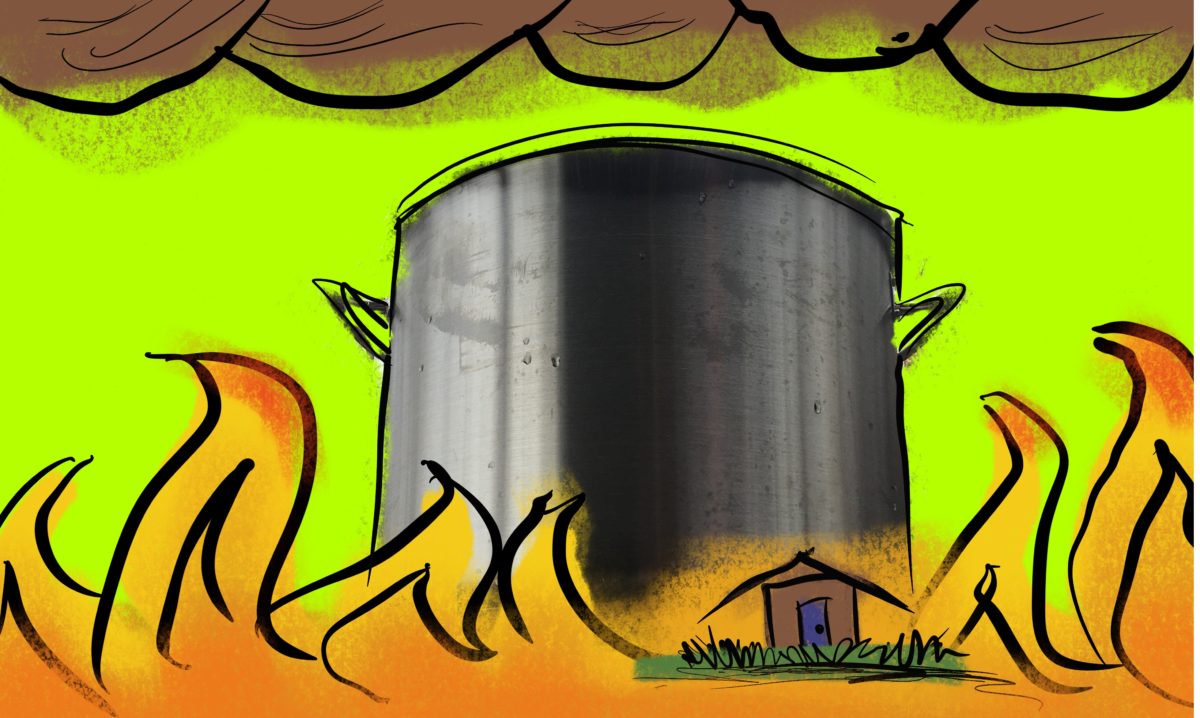My stockpot is huge. This is not a boast. In fact it may be more like an accusation.
Its predecessor had been tiny and flimsy and cheap, half a grade tougher and thicker than something you might sculpt out of aluminum foil. It’s probably better to think of it as a(n extremely feeble) pasta-pot—albeit one too short to do right by a pound of, say, bucatini. Fluid leaked through the crappy little rivets that held the handles on; the stock (or pasta-water) would dribble down the sides and drip into the burner and smoke. So you couldn’t even heat as much liquid as this shitty little pot might seem to fit; by the end, there’d only be as much as could burble calmly below the level of the handles. Maybe a gallon. Maybe.
I am the grandson of a Latvian man who once bought a set of clearance-priced duck decoys and mounted them decoratively in the tree out front of his home because it seemed irresponsible to pass up such a steep discount; who would mix powdered lemonade and jug wine and call it as good a Sangria as anyone ought to expect. Eastern Europe runs deep in these veins, is what I am saying. I used that piece of shit aluminum-foil coffee mug as a soup and stock and pasta pot for over a decade. It worked! You don’t throw away something that works!
One day one of the handles just came off. It happened to be over the sink at the time, and so the feeble near-gallon of salty, boiling pasta-water mostly went down the drain instead of onto the floor or onto my dick and balls, which is something to be glad about I guess. But the pot was dead. The time had come to replace the pot.
I’d like to direct your attention back up there to the duck decoy thing. That is not only the story of a person with a perhaps miscalibrated understanding of the nature or purpose of frugality. It is also the story of a person with bad shopping judgment. My grandfather was not a hunter. He had no use for duck decoys at any price. By all rights their deeply discounted price ought to have meant nothing to him: Even at one cent per duck decoy, that is not a good deal if you are a person who has no use for duck decoys. That is the appropriate price you ought to spend on duck decoys, multiplied by infinity.
Anyway, I bought a 40-quart stockpot off a restaurant supply website. Maybe you, as I have come to know about myself, are bad with picturing liquid volumes in your imagination. There was a photograph on the website of the 40-quart stockpot, with, like, the arm of a chef dropping some chopped mirepoix into it. It looked like a real big pot. It is a real big pot! But it is not a real big pot in the sense that, like, a normal person who cooks in a plausible human dwelling ought to be thinking about the phrase “real big pot.” Picture the Death Star. Picture the grey-faced working stiff who runs the operations department on the Death Star. Picture that doofus looking out an open loading bay along the vast curve of the Death Star’s side and seeing a stockpot floating in space and thinking “No way we can fit that thing in here.” I store my stockpot in the garage, is what I am saying. Imagine the Rose Bowl filled to the brim with simmering chicken stock. This is all a little bit beside the point.
Maybe you have your own stock-making routine. If you do not, here is a way to make extremely good chicken stock: Fill the bottom half of a stockpot with chicken bones or bone-in chicken parts (if you are using a 40-quart stockpot, this will necessitate the sacrifice of entire bird villages), and then fill the pot with very cold water. Then very slowly bring this water to the very gentlest of simmers—so that the surface of the water is only mildly roiling but not bubbling and certainly nowhere even in the outer vicinity of boiling—on your stovetop. Now lower the heat and maybe add some salt and throw a lid on there and let the chicken stuff simmer in there for two or three or four hours.
Next, chuck in lots and lots of big uniformly chopped chunks of whatever good aromatic stuff you like—onions, carrots, celery, leeks, shallots, maybe some parmigiano rinds if you’re thinking of skewing Italian in your stock-uses—that can impart flavor and aroma to the stock but which can’t stand up to quite as much simmering as the chicken parts without their flavors being smeared into oblivion. Throw the cover back on and let that stuff go for another hour or so. Then, when there’s just about a half an hour left to go, tie up a little cheesecloth bundle of last-minute stuff—sprigs of thyme, parsley stems, bay leaves, black peppercorns, maybe a smashed clove of garlic—and drop it in there. (If you tie the bundle up with twine, leave a long end and tie this to the handle of your stockpot so that you can easily retrieve the bundle—the sachet d’épices, it’s called—when you’re ready.) Wait a half-hour, or maybe 40 minutes. Et voila: Chicken stock. Turn the stove off.
Now what? Now you (or I) have a gigantic fucking 40-quart oil drum of hot chicken stock—far too much to use right away, unless you were planning on serving it to everyone in a modest-sized city. The thing to do with this stuff is to store it, so that you can use it later: to soak and simmer beans, to flavor sauces, to make risotto or chicken soup, to season and drink out of mugs. To store the stock, and to ensure it keeps as long as possible, it will need to be separated carefully from the solid matter that flavored it, and it will need to have the fat removed from it. It will also need to be cooled, of course. All of this is very sensitive.
You can dump the stock through a colander, but this is a rather violent way to remove the now-mushy solids and will tend to suffuse the stock with cloudy particulate food that will make it look bad and spoil more quickly. A better approach is to ladle the clear golden liquid out of the pot one scoop at a time and pour it through a double-layer of cheesecloth into some other vessel or vessels for storage. The layer of liquid fat on top of the stock can make this annoying, and anyway the fat isn’t invited to the next stage of the stock’s existence. So the even better thing to do is to remove the fat before you remove the solids. But of course the fat is just a layer of liquid on top of another layer of liquid, and you could spend a month carefully skimming this shit off with a spoon or whatever if your goal is to remove it without also removing half of the stock. So the absolute better-est thing to do is to cool the stock first, before you do anything else with it; this will cause all of the fat to congeal into a single solid puck on top of the stock, and then all you have to do is pull the puck out of there (and cram it into a storage container and keep it in the fridge and use it as a cooking fat) and you can move onto the ladling part.
The problem, for The Ancients, was that nobody had invented the refrigerator yet. The problem for me is a descendent of that bygone one: Nobody, so far as I know, has invented an affordable consumer-grade refrigerator halfway large enough to host a 40-quart stockpot, likely not least because most consumers are not stupid enough to purchase a 40-quart stockpot. The Ancients had a solution to this, more or less, or at least to some part of it. It was called “winter.”
What you did was, you took your pot of hot stock outside into the cold winter before you went to bed, you found a reasonably safe and stable place for it, and you just parked it there, with maybe a heavy rock sitting on the lid to make things difficult for enterprising raccoons. By the next morning the stock would be cold but not yet frozen, and the fat would be a nice solid puck easily removed. Then you could move onto separating the stock from the solid food.
This is what I attempted last week, a late-January week, the dead middle of winter here in the low mountains of western Maryland where I live at elevation and where the dead middle of winter typically has been miserably cold and has necessitated much annoying snow removal. Stock-making, among all its other virtues and benefits, is a way to make a temporary and happy peace with the horrors of the worst season: If the bitter wind and thin, cruel air can freeze your nose and make the act of moving about in the outer world clad in less than a goddamn spacesuit into a nightmare vision of hell, well, shit, they can also cool your pot of stock for you, and then you can have some good stock to live by until spring. This was the idea. I have been unemployed since the day before Halloween; I was unemployed on Christmas; this has been a hard winter and it seemed important to try to make peace with something, to accomplish some damn thing.
But an uncomfortable thing I have learned about trying to broker a truce with the horrors of winter is that, if they do not appear, their absence—which I’d ordinarily welcome like a surprise visit from an old friend—becomes its own kind of horror. The stockpot was still hot to the touch the next morning, down at the bottom. Hot. I cannot express to you the queasy revulsion this aroused in me, the clammy, panicky feeling of doom. Not only that the night of January 27, 2020 hadn’t been cold enough—not nearly!—to cool a pot of chicken stock left outdoors overnight the way people at this latitude and elevation have been leaving their pots of chicken stock outdoors overnight to cool for whole actual centuries, but the sudden sharp realization that in this entire winter so far there have been maybe, what, one or two actual winter nights, that the rest of it has never gotten colder or harsher than what what once, and alarmingly recently, characterized mid-October.
I suppose I should be ashamed to admit that no story of glacial retreat or food-chain collapse, no ominously red-colored map of global temperatures, has made the changes the world has undergone just in my lifetime feel as real or as claustrophobically present as the touch of that steel pot, the sight of the still-liquid fat slicked across the surface of the stock. Maybe that’s how it works, or maybe it’s just how myopic and stupid I am. I salvaged enough stock to make Italian wedding soup with little meatballs and shreds of chicken thigh and served it with acini di pepe, and socked away three more big jars of the stock—each containing more fat than I’d like—in the freezer, the only legitimately wintery place I can get to right now, on February 1, 2020, in the dead middle of winter in the low mountains of western Maryland.
It’s not half bad stock, all in all, if a little heavy on despair.




Peter Caster says:
Laughed multiple times, especially because I started my chicken stock this morning at about 10 AM, and because I live in SC and don’t have a restaurant/dinosaur-sized stock pot, I’m about to put mine in the fridge. Using a colander, though–I’m lazy.
February 1, 2020 — 1:09 pm
Zach says:
Laziness aside, do you, or Albert, or anyone own both a 20-quart colander and a separate ~30-quart container to dump the 40-quarts of solid/stock stuff into? Where would you even do this? Would you put the 30-quart container in the bathtub? I guess outside would work since, as mentioned, it’s been worryingly warm this “winter”.
I’d probably pay to see Albert try and accomplish this.
February 3, 2020 — 12:19 pm
ellen friedman says:
cmon burneko marry me already. you won’t regret it
February 1, 2020 — 1:12 pm
Ma Burneko says:
I will lease him to you for a case of real-deal Moxie in glass bottles and a moderately priced insurance policy
February 1, 2020 — 2:58 pm
IP says:
Pragmatic!
February 1, 2020 — 3:25 pm
NeverActuallyCommentedOnDeadspin says:
Oooof. Wrangling my 12-quart pot of stock is a giant hassle–I’m so glad you went for it with one 4x that. Do you ever boil your stock down into, like, portable soup cubes? Regardless, I missed your uncompromising food takes, man. Thanks.
February 1, 2020 — 1:16 pm
hampineapple says:
I just started doing this to save on freezer storage and so far so good!
February 1, 2020 — 6:32 pm
Rebel Yelich says:
Thank God for UTSB and the return of all the splendid bloggers. With the gain comes the pain of missing (forever?) the awesomeness of Foodspin. Albert, we love you; stop being so lazy.
February 1, 2020 — 1:19 pm
Souper Bowl fan says:
Oh man, I have so many regrets about my 40 qt.
The one thing it’s good for is making a 24 hour stock/bone broth. I can leave that shit on the stove over night and not worry about all the liquid cooking out.
February 1, 2020 — 1:29 pm
GlassOfWaterBuffalo says:
This is one of MANY MANY reasons this here blog needs to remain functional, accessible, and chock full of sweet, sweet CONTENT well past tomorrow’s expiration date. More food articles please. Now and forever. Thanks
February 1, 2020 — 1:32 pm
John says:
Hi Albert,
Thanks for this. Miss your writing, man. Hope to support whatever is next for you.
February 1, 2020 — 1:34 pm
TeeHack says:
My thoughts exactly
February 1, 2020 — 3:35 pm
Primer says:
+10
February 1, 2020 — 4:59 pm
UTSB: a new hope says:
+100
February 2, 2020 — 6:11 pm
GuyFierisH2O2Dealer says:
Foodspin is (temporarily) back! This is the cherry on top of the sundae that is this website’s comet-like return during an otherwise horrific week. We are not worthy.
Agree this season is underrated for its value in chilling large foodstuff quantities. I sit my stock on a cast aluminum table for this purpose so it will theoretically conduct the heat out of the pan bottom quicker. Its also a great time of year to solidify bacon fat for quick disposal (I cook mine in a sheet pan lined w parchment paper and leave the pan out. when fat hardens just fold up and dispose; pan is clean).
Agree, this non-existent Maryland winter (somewhat of an oxymoron to start anyway) sucks. We’re not collectively making it to 2021 anyway, so smoke em while you got em, and raise a glass to Dashlane, thankyouverymuchguys.
February 1, 2020 — 1:44 pm
BurnyMcBurnerface says:
UTSB has to become permanent. I would pony up cash each month to read this crap. Just sayin.
February 1, 2020 — 3:21 pm
NotThatMattButADifferentOne says:
I’d put up $10 or $15 a month for the rest of my life so this would stay alive.
I like this better than Netflix and the Washington Post and Apple Music and whatever other things my wife subscribes to without asking me, so I guess I’m just saying that my wallet is flapping around and I really want someone to take my money.
February 1, 2020 — 8:46 pm
Bort says:
Do you get her permission for things?
February 4, 2020 — 2:43 pm
I WILL PAY FOR THIS GODDAMN CONTENT says:
We had some friends over last weekend and I bought a case of some cheap beer in the event our guests ran out of whatever they brought, and left it outside as the fridge was full.
It turned into a not disappointing, but tamer night than I anticipated, so the case was left out OVERNIGHT in OTTAWA CANADA, in GODDAMN JANUARY.
I remembered by the following afternoon, cursing myself for all 24 of those little soldiers, all frozen inside with their little caps popped off, resting on a small pile of beer slush poking out of the neck of each bottle.
They all made it, now I’m left with 24 bottles of “No Name beer” I have no idea what to do with.
Climate change is real, and it is here.
February 2, 2020 — 9:43 am
I WILL PAY FOR THIS GODDAMN CONTENT says:
Dammit I replied in the thread. This layout is new I’m sorry. Anyway, hi from Canada.
February 2, 2020 — 9:47 am
Awesome's Razor says:
Mmmmm, Italian wedding soup and existential crisis.
February 1, 2020 — 3:22 pm
Count Tolstoy says:
LONG LIVE FOODSPIN!
February 1, 2020 — 3:41 pm
Jersey Joe says:
Great work Albert. Thanks for listening to my request. I needed a laugh after my all- purpose Brother copier jammed for the umpteenth time. Thanks and also to Dashlane, which I already have. You and your crew are the best. I hope this Blog never dies.
February 1, 2020 — 4:54 pm
Well Placed Rocket says:
“to season and drink out of mugs”
Does anyone do this? It has never occurred to me. Seems like peak grandpa behavior. I won’t knock it until I’ve tried it, but there is a chance here that Burneko is an unforgivable lunatic. But maybe he’s a genius.
February 1, 2020 — 6:05 pm
Fart Barfunkel says:
I do it. Its great for when you need a hot drink but you can’t have any more coffee or your heart will explode.
February 2, 2020 — 1:07 am
UnnamedTemporaryCommenter says:
Negative. Stock is to be drunk only when sick.
February 2, 2020 — 1:08 am
Lumpfish says:
It makes me sad that many of the comments don’t seem to get the point of the OP, i.e. that making chicken stock is just a figure of all the little mundane things that are going to keep getting ever more totally fucked as we jog down the path to climate apocalypse. It’s not just fires and floods. All of our routines, and even our built environments, are tuned to a narrow climate window (which is NOT the same as weather variability), and even a 1° C increase throws pretty much everything out of whack.
The point is, now, even Chicken Soup weighs heavy on the soul.
February 1, 2020 — 6:45 pm
foroldtimessake says:
+1
February 2, 2020 — 2:56 am
Promo code IDIOTS says:
I hung onto every word about chicken stock creation and besterest ways to remove fat and solid mush from said chicken stock. I’ve never made stock of any kind in my life. What I’m saying is that this is very good writing that deserves to be permanent.
February 1, 2020 — 6:51 pm
Tim M. says:
I’ve missed a lot of things about deadspin, but perhaps nothing moreso than Burneko writing about how to cook food.
February 1, 2020 — 7:57 pm
Bob says:
I’m in Central Maryland, and have thought about how I should do a full-boil homebrew beer on the propane burner out back, but that the groundwater is probably not really cold enough to cool 5 gallons of wort quickly, because it hasn’t been piss-awful cold for more than a few days in a row.
February 1, 2020 — 8:26 pm
Torsloke says:
In this unrelenting, inescapable hellscape epoch, it feels so unlikely that we should be so blessed. I chuckled that we got a Jamboroo, caprices by Ley and Theisen and Petchesky, but two (!) Ratto articles, Diana doing the work, and an honest-to-god Foodspin. I’m going to be so pissed when I wake up from this dream.
February 1, 2020 — 9:38 pm
devil's plaything says:
I don’t cook, but even I enjoy the foodspin articles. Please make UTSB permanent. I will pay actual money for a subscription.
February 1, 2020 — 9:41 pm
IntentionalEwok says:
Damn, I miss you guys.
February 1, 2020 — 10:41 pm
Searoc says:
Your chicken thighs on the grill post is yearly summer reading. This was a great read too. Feelings!
February 2, 2020 — 12:52 am
C. says:
Unnamed Temporary Food Blog
February 2, 2020 — 6:48 am
Thunder says:
That is a good drawing of a big pot. It will haunt my dreams.
Now do one of the ducks.
February 2, 2020 — 9:48 am
ATDMWTH says:
Been waiting for one of your food blogs for years. I was able to scrounge a similar sized stock pot from the dumpster of my apartment complex. It’s first life was a turkey fryer.
February 2, 2020 — 6:33 pm
Steve says:
I have a 16 quart stock pot that I foolishly purchased, and everyone around me that has never worked in a professional kitchen acts like it’s the largest pot they’ve ever seen.
What I’m saying is I understand, and I’m sorry.
February 3, 2020 — 10:29 am
RedMenace75 says:
You buried the lede. Title this “FOODSPIN IS BACK (FOR THE WEEKEND), BITCHES!!”
Good to have you back, Burneko.
February 3, 2020 — 11:30 am
gt9729b says:
I rolled the dice and hoped that UTSB’s stuff wouldn’t be removed Monday. That paid dividends when I was able to finally read this today. Wonderful stuff, always loved your writing.
I really do want to keep this going!
February 6, 2020 — 9:17 am